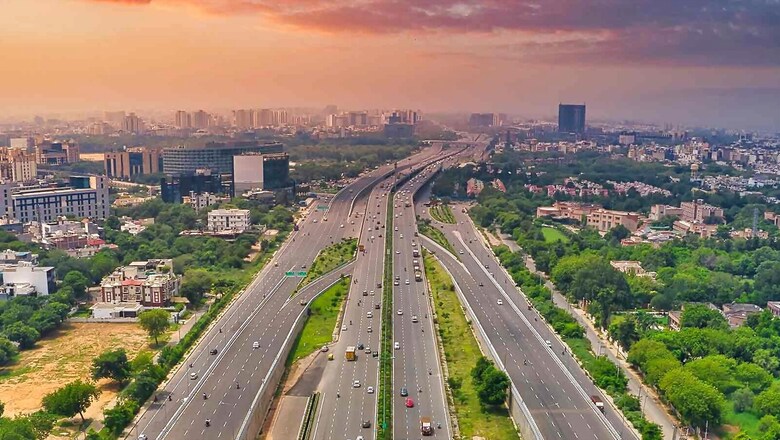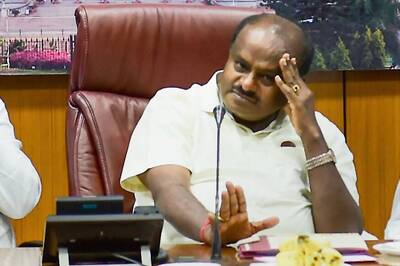
views
At the milestone marking 75 years of Independence, in his address to the nation from Red Fort, PM Narendra Modi talked about embracing the Panch Pran by 2047. The first of these Panch Pran is the goal of a developed India. To make this goal a reality, the road goes through infrastructure development.
Since 2014, the GOI has made strategic investments that make it possible to start, run and succeed with a business in India. One of the most noticeable gains has been in the area of infrastructure. India boasts of the second largest road network in the world at 63.73 lakh kms, and holds the world record for the blistering pace of growth: Indian roads are growing at the rate of 38 kms per day, and the rate is set to improve. Our roads transport 64.5% of all goods in the country and 90% of India’s total passenger traffic.
This growth is part of a larger infrastructure plan called the Gati Shakti National Master Plan. Infrastructure is crucial to the development of any economy. Roads, railways, airways, and waterways enable connectivity with the outside world, facilitate trade and bring prosperity to the regions they connect. Infrastructure has a high multiplier effect. The Reserve Bank of India (RBI) and the National Institute of Public Finance and Policy estimate the multiplier to be between 2.5 and 3.5 – that is, for each Rupee spent on infrastructure, we can expect the GDP to rise by Rs 2.5 to 3.5.
Of course, where this money is spent is of paramount importance. India’s Gati Shakti program has consolidated a list of 81 high impact projects, of which road infrastructure projects were given top priority. Major highway projects include the Delhi-Mumbai expressway (1,350 kilometres), Amritsar-Jamnagar expressway (1,257 kilometres) and Saharanpur-Dehradun expressway (210 kilometres).
The mission is a singular one: to bring together all the various players into one platform, and create a blueprint that creates multi-modal connectivity. Multi-modal connectivity means that goods and people will move seamlessly from one mode of transport to another, facilitating last mile connectivity and reduced travel time. Multi-modal connectivity also enables the creation of complex supply chains, conferring several advantages on Indian businesses.
As with all things, implementation will be key. With a project this big, it is important to keep wastages and rework to a minimum, and that is where quality standards come in. A robust performance monitoring framework is required to ensure high quality output and timely completion of projects. This is why the Quality Council of India (QCI) is working with the entire ecosystem: setting quality standards, training auditors and consultants, and creating frameworks for objective assessments.
Setting the benchmark for performance
Making roads in India can be an uphill task (no pun intended). Projects often face some degree of time and cost overruns. Often the problem lies in poor planning and design, often land acquisition and clearances take longer than anticipated, funds aren’t utilized optimally, there are lapses in construction best practices, and sometimes, a good old fashioned dispute between various stakeholders can derail a project timeline and budget. The quality of construction, as well as project management, is often sub-par.
To set themselves up for success, the Ministry of Road Transport & Highways (MoRTH) engaged QCI to develop a performance rating model for highway construction vendors and design a framework for incorporation of performance rating in future bidding process. In order to formulate both the framework and methodology, QCI undertook extensive research: it evaluated codes and standards, reviewed international performance rating models and consulted with various experts from the sector.
The resulting framework takes into account different modes of implementation and stage of progress of these long term projects. The assessments are holistic: evaluating vendors on parameters like quality of construction, timely submission of progress reports and audit reports, adherence to guidelines and IRC (Indian Roads Congress) codes, compliance with industry standards and specifications and overall process management. Each vendor needs to support their claims with documentary evidence, creating a clear documentary trail for future reference.
In keeping with QCI’s approach, the framework wasn’t immediately rolled out, but first pilot tested on 20 national highway projects. The results from the pilot were used to refine and improve data management protocols, to standardise data and remove process bottlenecks. QCI also presented a roll out model to smoothly scale the performance rating framework to all national highway projects in India. Moreover, QCI also designed a framework to incorporate these performance standards in future bids, and a way for past performance data to be factored into future bids as well.
QCI also developed a rigorous assessment framework and process roadmap to identify and award the best performing companies in the highway development sector. These awards were designed across five categories, recognizing excellence in Construction Management, Operation and Maintenance, Toll Plaza Management, Highway Safety and Innovation. As with the performance rating framework, the awards took into account the mode of implementation, terrain and construction technique; and for each category, the projects were assessed on objective and quantifiable parameters.
Creating an ecosystem of quality
Beyond particular performance standards, QCI also creates an ecosystem of quality by way of establishing standards, enforcing these standards, and creating a steady supply of accredited consultants and organisations that can perform both quality and environmental audits. Each of the boards within QCI serve a key purpose in raising the bar of quality in all walks of life.
Specific to roads and highways construction, the National Accreditation Board for Education and Training (NABET) lays the groundwork through the provision of an accreditation mechanism in the arena of skills, education and training. This creates a steady pipeline of education and training providers whose training outcomes can be trusted. The National Accreditation Board for Certification Bodies sets the standard for all certification bodies, creating the foundational bedrock of quality in action in India. Accreditation schemes like Business Continuity Management Systems (BCMS), Energy Management Systems (EnMS), Environment Management Systems (EMS), Occupational Health and Safety Management Systems (OHSMS), Quality Management Systems (QMS), Inspection Bodies (IB), Personnel Certification Bodies (PrCB), Product Certification Bodies (PCB) and other relevant certifications make it possible for project sponsors and project managers to run a tight ship on their projects from day one.
In addition, QCI has also helped stakeholders ease into the regulatory norms specified under the Environmental Impact Assessment (EIA), which is a statutory requirement for most developmental and industrial activities in India. It is also being progressively used by financial institutions to assess the soundness of investment in a given project. QCI’s NABET has developed a voluntary accreditation scheme, making available consultants and auditors who can help ensure compliance to EIA norms, and prepare EIA reports for obtaining environmental clearance. The availability of trained auditors and consultants has eased a very important bottleneck, while also raising the quality and sustainability profile of infrastructure projects in India.
Moreover, in some cases, QCI’s Project Planning & Implementation Division (PPID) also works directly to implement particular projects, schemes or initiatives; executing them in their entirety. This means that QCI runs the entire project management lifecycle: formulating project methodology along with focus areas, surveys and stakeholders; creating of the project plan and timelines, and resource plans; coordinating with various stakeholders (govt. agencies at centre and state levels, Urban Local Bodies (ULBs), Tech and PR agencies and other stakeholders); and finally, executing the project, while monitoring performance in real time.
In this way, QCI makes it possible to bake in quality into infrastructure projects of all sizes and timelines, from the moment of conception to when they are finally made open to the public. This not only creates confidence in the safety and longevity of these projects, but also helps minimise cost and timeline overruns. For a government that wants to march India steadily into the future, this payback in terms of both time and value, is immeasurable.
Conclusion
India was once considered the jewel in the crown of the British Empire. 75 years after we’ve shrugged off the yoke of the British, India is demonstrating its leadership potential as an economic superpower, a thought leader in sustainability, and in the soft power that comes from a highly qualified, well respected Indian diaspora.
India’s wealth is growing, as Indian businesses become more and more competitive in an increasingly global marketplace. In this critical stage of our growth as a nation, the governments’ investments in roads and infrastructure are set to unleash several multipliers. The roads themselves unleash a whole knock on effect on allied industries: steel, cement, auto, real estate. Everything moves upwards, bringing with it the median incomes in these areas.
As easy movement of men and materials opens up new markets and suppliers for businesses, and more choices for consumers, Indian businesses compete against each other on a level playing field, boosting healthy competition and the emergence of best in class processes, products and services.
We all get better at what we do. And that is always good for business.
This is a partnered post.
Read all the Latest News here




















Comments
0 comment